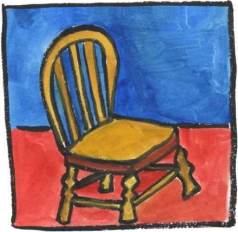After you've experienced the workshop lessons in our Easier Sitting collection, you might enjoy reading these dynamic sitting principles.
These ideas are presented as directions of inquiry and development in your relationship with sitting, long term. None are expected to be changes you make overnight, or new “shoulds” to beat yourself up about! Rather, the Feldenkrais learning process seeks to enrich your sensory life and self awareness, and to present you with options you may not have considered before, so that it becomes more and more interesting and pleasant to try out non-habitual choices when the habitual ones are painful or unsatisfying. Comfort first! If you don’t like the sensation that an idea, principle, or movement experiment creates in you, don’t force it.
- Skeletally neutral sitting has a “center” or “home position” where the sitbones and pelvis, the spine, and the head are all arranged long and tall vertically, plumb with gravity. From this home position we are free to look, move, lean, turn, shift, and act with our arms and hands as life requires. We’re seeking to learn to feel the comfort and value of returning “home,” and to cultivate this position’s desirability by getting free of our long held habits that compete with it. When we’re “home” we’re mostly supported by bones, which evolved for the anti-gravity job and don’t tire like our soft tissue does.
- There are a lot of options and valuable games to be played in sitting where the pelvis and head remain on a single a plumb line, even as the spine between them bows out in any direction. We did this in both the sagittal plane (rounding and arching) and the frontal plane (side-bending), and then in circling the weight of the pelvis (which moves the spine among those two planes). We can learn to become aware of this from either end of the axis (head and pelvis), or both ends simultaneously. We can even focus on the bowing out movements of the middle of the axis when the ends are tipping together (the middle of the spine moving L, for example, while the R ear drops down as R sitbone lifts up).
 To enable 1 & 2, we need to cultivate the lively, dynamic relationship our sitbones can have with our seat and our seated posture and movements. Seats that are level and relatively firm make these sitbone sensations much easier to feel and provide better support for the skeleton. Obviously you’ll need to take a break from firm seats from time to time, especially if you’re not used to them.
To enable 1 & 2, we need to cultivate the lively, dynamic relationship our sitbones can have with our seat and our seated posture and movements. Seats that are level and relatively firm make these sitbone sensations much easier to feel and provide better support for the skeleton. Obviously you’ll need to take a break from firm seats from time to time, especially if you’re not used to them.- It’s also a lot easier to explore 1-3 if our seats allow our pelvis to be slightly above our knees and our feet are on the floor in front of us. If you are tall or have long lower legs, this often requires augmenting the height of the chair with folded towels or mats, a yoga block, or even large books. Plus, the slightly-wider-than-your-hips knee width and freedom is skeletally neutral even if it’s culturally/habitually unfamiliar. (When I lived out east I often asked New Yorkers to picture “a dude on a subway, taking up more than his fair share of room," and asked them to practice being that guy!)
- Level and firm seats pass the chair test, which is “Don’t sit on it if you wouldn’t stand on it!” A lot of seats in our life don’t pass this test, and complicate or prevent any of the freedom of 1-4. It’s not that we can’t use these chairs, but we should minimize their use and/or use pillows or folded towels or other support to make them work better for us, and get things a little closer to plumb.


I very much enjoy Nick’s lessons. His instructions are extremely clear and understandable, it’s just a pleasure listening to him!